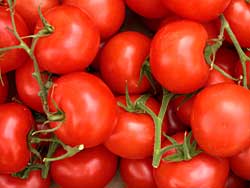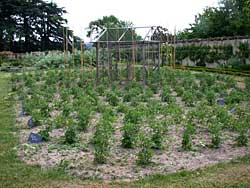

It is common knowledge that the tomato originated in the New World and was brought to Europe by the early Spanish explorers.1 It is also common knowledge that for much of its early existence in Europe, the tomato was considered poisonous and was used only as an ornamental plant.2 What may not be as well known is how pervasive the tomato is in modern times in French cuisine.
The tomato, tomate in French, first came to Provence from Italy in the last half of the eighteenth century. It was a group of Provençales who introduced Paris to the tomato on July 14, 1790 as part of an early celebration of the new republic.3
Early cookbooks show tomatoes being cooked, primarily for sauces or stuffed with other ingredients.4 Soups and vegetable casseroles, gratins, make up the next most common uses of the tomato in French cooking. Today, tomatoes are often consumed raw in salads and other dishes.

Typical tomates en grappe at an outdoor market in the Loire Valley.
Although the tomatoes available in French markets can be divided into six general categories based on size and shape, my personal experience is that most of the tomatoes I’ve been exposed to are en grappe, tomatoes sold as a cluster, still attached by their stems to a small section of branch. With a size of about eight centimeters in diameter, they seem to be ideal for many dishes. Other categories of fresh tomatoes available include tomates côtelée (ribbed tomatoes), tomates ronde (round tomatoes), tomates cocktail (cocktail tomatoes, similar to tomates grappes except smaller), tomates cerise (cherry tomatoes), and tomates allongée (plum tomatoes).5 At the Château de la Bourdaisiere near Montlouis in the Loire Valley, they are attempting to gather as many of the world’s varieties of tomatoes as possible. So far the curators have collected over 500 different varieties that they plant each year in their garden.6

An early planting of some of the hundreds of varieties of tomatoes grown at the Château de la Bourdaisiere.
With a per capita consumption of 10 to 15 kilos per year, tomatoes are the number one fresh vegetable consumed in France.7 Maybe, that’s why tomatoes seem to have a ubiquitous presence in modern cookbooks and cooking magazines. It is difficult to find a magazine that doesn’t have at least one recipe using tomatoes, and many have a handful. The same is true with cookbooks. Unless the subject would explicitly exclude tomato products, such as a book on pâtisserie, it is hard to find a cookbook that doesn’t have at least one recipe featuring tomatoes and many have quite a few. There are even a few cookbooks that feature tomatoes in every recipe.
In selecting the tomato recipes that I would test for possible inclusion in this article, I strayed from my usual method. Normally, I would go through my entire library listing all the possible recipes and then select a “balanced” variety to test. For this article, I grabbed a couple of books off the shelf and just started selecting a recipe or two from each to try. There would have been too many recipes to select from if I went through all my resources.
The most common type of recipe I found were those for some form of a cooked tomato sauce. I decided to use an early one from the first half of the nineteenth century by Marie-Antoine Carême, sauce tomate, as representative of the whole group. Two other recipes create a sauce as part of their creation: moules au basilic et à la tomate and chipirons aux tomates. I’ve also included the ultimate, modern, all-purpose tomato sauce: ketchup maison. The next most common type of recipe seems to be those for stuffed tomatoes. An 1867 recipe, tomates farcies, for a tomato stuffed with mushrooms was chosen as representative of traditional recipes. Tomates farcies à la tomate and soufflé aux tomates et avocats are modern stuffed-tomato recipes, the latter being suitable as an entrée rather than as a side dish (garniture) like the former.
The other, modern ubiquitous tomato recipe seems to be for tomato tarts. An entire article could easily be written based on the various versions for tomato tarts I found. I settled on tarte à la tomate et moutarde because of its simple preparation and its ability to bring out the flavor of the tomatoes.
Other side-dish recipes in this article include tian aux tomate, aubergine, et courgette; clafoutis aux tomates cerises; and tomates au tapioca. The recipes below that are suitable as entrées, or even for brunch menus, include pipérade; salade de tomates, poulet et gingembre; salade de tomates à la tapenade; and tartare de tomates mozzarella. There are two soup recipes, both cold: soupe façon gaspacho and soupe de tomates fraîches au pistou. There’s also one dessert recipe: verre de tomates au Muscat.
In addition to these new recipes, there are an additional 14 or so tomato recipes already listed in the recipe index of this site. Although together, these make a nice little selection of tomato recipes, it would be easy to pick a few hundred more.

1. I Say Tomayto, You Say Tomahto.... Online at Tomato History. Cited 13 July 2004.
2. Tomato. Online at DiWine Taste. Cited 13 July 2004.
3. Dans votre assiette : la tomate. Online at e-sante.fr. In French. Cited 13 July 2004.
4. Marie-Antoine Carême, L’art de la cuisine française au dix-neuvième siécle, 1833. In French.
5. A chaque tomate ses plaisirs. Online at Tomates de France. In French. Cited 11 July 2004.
6. Le domaine d’un Prince curieux. Brochure from Château de la Bourdaisiere. Obtained 30 May 2004. In French.
7. La bataille du goût — La tomate. Online at TV France5. Cited 13 July 2004. In French.
©2004, 2014 Peter Hertzmann. All rights reserved.









































